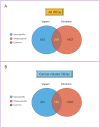The Untapped Biomarker Potential of MicroRNAs for Health Risk-Benefit Analysis of Vaping vs. Smoking
- PMID: 39195220
- PMCID: PMC11352591
- DOI: 10.3390/cells13161330
The Untapped Biomarker Potential of MicroRNAs for Health Risk-Benefit Analysis of Vaping vs. Smoking
Abstract
Despite the popularity of electronic cigarettes (e-cigs) among adolescent never-smokers and adult smokers seeking a less pernicious substitute for tobacco cigarettes, the long-term health impact of vaping is largely unknown. Like cigarette smoke, e-cig vapor contains harmful and potentially harmful compounds, although in fewer numbers and at substantially lower concentrations. Many of the same constituents of e-cig vapor and cigarette smoke induce epigenetic changes that can lead to the dysregulation of disease-related genes. MicroRNAs (MiRNAs) are key regulators of gene expression in health and disease states. Extensive research has shown that miRNAs play a prominent role in the regulation of genes involved in the pathogenesis of smoking-related diseases. However, the use of miRNAs for investigating the disease-causing potential of vaping has not been fully explored. This review article provides an overview of e-cigs as a highly consequential electronic nicotine delivery system, describes trends in e-cig use among adolescents and adults, and discusses the ongoing debate on the public health impact of vaping. Highlighting the significance of miRNAs in cell biology and disease, it summarizes the published and ongoing research on miRNAs in relation to gene regulation and disease pathogenesis in e-cig users and in vitro experimental settings. It identifies gaps in knowledge and priorities for future research while underscoring the need for empirical evidence that can inform the regulation of tobacco products to protect youth and promote public health.
Keywords: epigenetics; gene expression; miRNA; smoking; youth vaping.
Conflict of interest statement
The authors declare no conflicts of interest. The sponsors of the study had no role in the study design, data collection, data analysis, data interpretation, writing of the report, or in the decision to submit for publication.
Figures




Similar articles
-
Electronic Cigarette-Derived Metals: Exposure and Health Risks in Vapers.Chem Res Toxicol. 2025 Apr 21;38(4):542-556. doi: 10.1021/acs.chemrestox.4c00520. Epub 2025 Mar 17. Chem Res Toxicol. 2025. PMID: 40094421 Review.
-
Exploring the Utility of Long Non-Coding RNAs for Assessing the Health Consequences of Vaping.Int J Mol Sci. 2024 Aug 5;25(15):8554. doi: 10.3390/ijms25158554. Int J Mol Sci. 2024. PMID: 39126120 Free PMC article. Review.
-
Exosomal microRNAs are novel circulating biomarkers in cigarette, waterpipe smokers, E-cigarette users and dual smokers.BMC Med Genomics. 2020 Sep 10;13(1):128. doi: 10.1186/s12920-020-00748-3. BMC Med Genomics. 2020. PMID: 32912198 Free PMC article.
-
Lipid laden macrophages and electronic cigarettes in healthy adults.EBioMedicine. 2020 Oct;60:102982. doi: 10.1016/j.ebiom.2020.102982. Epub 2020 Sep 10. EBioMedicine. 2020. PMID: 32919101 Free PMC article.
-
Differences between Dual Users and Switchers Center around Vaping Behavior and Its Experiences Rather than Beliefs and Attitudes.Int J Environ Res Public Health. 2017 Dec 23;15(1):12. doi: 10.3390/ijerph15010012. Int J Environ Res Public Health. 2017. PMID: 29295483 Free PMC article.
Cited by
-
Electronic Cigarette-Derived Metals: Exposure and Health Risks in Vapers.Chem Res Toxicol. 2025 Apr 21;38(4):542-556. doi: 10.1021/acs.chemrestox.4c00520. Epub 2025 Mar 17. Chem Res Toxicol. 2025. PMID: 40094421 Review.
References
-
- Bozier J., Chivers E.K., Chapman D.G., Larcombe A.N., Bastian N.A., Masso-Silva J.A., Byun M.K., McDonald C.F., Crotty Alexander L.E., Ween M.P. The Evolving Landscape of e-Cigarettes: A Systematic Review of Recent Evidence. Chest. 2020;157:1362–1390. doi: 10.1016/j.chest.2019.12.042. - DOI - PubMed
-
- Balfour D.J.K., Benowitz N.L., Colby S.M., Hatsukami D.K., Lando H.A., Leischow S.J., Lerman C., Mermelstein R.J., Niaura R., Perkins K.A., et al. Balancing Consideration of the Risks and Benefits of E-Cigarettes. Am. J. Public Health. 2021;111:1661–1672. doi: 10.2105/AJPH.2021.306416. - DOI - PMC - PubMed
Publication types
MeSH terms
Substances
Grants and funding
LinkOut - more resources
Full Text Sources
Medical

